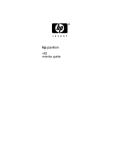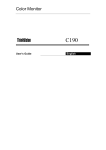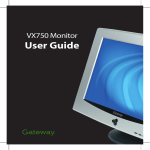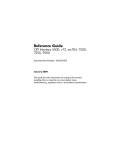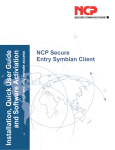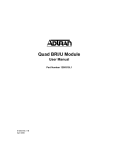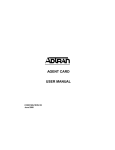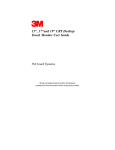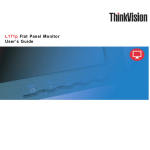Download IBM C190 User's Manual
Transcript
Color Monitor C190 User’s Guide English Contents Contents ..........................................................................................................1 Safety: Read first..........................................................................................2 Attaching the stand.......................................................................................3 Connecting your monitor ..............................................................................4 Workplace preparation .................................................................................4 Positioning the monitor .............................................................................4 Height .......................................................................................................5 Orientation ................................................................................................5 Working Practices ........................................................................................5 Rest ..........................................................................................................5 Back..........................................................................................................5 Hands .......................................................................................................5 Eyesight ....................................................................................................5 Screen settings .........................................................................................5 Installing the Device Driver...........................................................................6 Installing the Device Driver for Windows 95 or Windows 98 ........................6 Installing the Device Driver for Windows 2000 or Windows Me ...................7 Installing the device driver in Windows XP...................................................8 User Controls............................................................................................9 On-Screen-Display .....................................................................................10 Activating the On-Screen-Display ...........................................................10 Main OSD menu controls........................................................................10 OSD functions.........................................................................................10 Further information .....................................................................................14 Display modes ........................................................................................14 Power Management................................................................................14 Troubleshooting..........................................................................................15 Further help ............................................................................................16 Specifications .............................................................................................18 Service Information ....................................................................................19 Notices and Trademarks ............................................................................20 Notices....................................................................................................20 Trademarks.............................................................................................21 1 Safety: Read first 2 Important: Before connecting the monitor, turn off the computer and attached devices. Also ensure the power at the electrical outlet matches the power requirements of the monitor. Refer to the Specifications section on page 18 for more details. Attaching the stand 1. Place the monitor face down on a soft surface to prevent the screen being scratched. 2. Insert the hook (1) into the matching slots on the underside of the monitor (2). 3. Slide the base towards the front of the monitor until the latch (3) clicks into the locked position. 3 Connecting your monitor 1. Connect the signal cable to the video port on the back of your computer (figure A). Your computer may have a video adapter card installed. In this case, attach the signal cable to the connector on the video adapter card (figure B) 2. Connect the power cord to the monitor first, and then firmly insert the plug into a properly grounded electrical outlet. 3. Turn on the monitor, and then the computer. If your monitor does not seem to be working correctly, refer to the Troubleshooting section for help. Workplace preparation Positioning the monitor Choose a suitable place to position the monitor where it is not near fluorescent desk lighting or any equipment that produces magnetic fields that could cause interference. Ensure that the furniture or equipment can support the weight of the monitor. Allow at least 2 inches (50mm) ventilation space around the monitor. 4 Height Position the monitor so that the top of the screen is slightly below your eye level when you sit at your workstation. Orientation Choose a position that gives the least reflection form lights and windows, usually at a right angle to any windows. Position the monitor directly in front of you so that you do not have to twist your body. Tilt the monitor to a comfortable viewing angle. Working Practices Rest Take regular breaks. Vary your posture, and stand up and stretch occasionally, as prolonged use of computer workstations can be tiring. Back Sit back in the chair and use the backrest. Hands Use a light touches on the keyboard, keeping your hands and fingers relaxed. Allow a space in front of the keyboard to rest your wrists when not typing. Consider using a wrist pad. Eyesight Working with monitors, in common with any prolonged close work, can be visually demanding. Look away from the screen, periodically and have your eyesight checked regularly. Screen settings Set the screen brightness and contrast to a comfortable level. You may have to adjust this as the lighting changes during the day. Many application programs let you select color combinations, which can help you to view in comfort. 5 Installing the Device Driver Installing the Device Driver for Windows 95 or Windows 98 To install the device driver in Microsoft® Windows®95 or Windows98, do the following: Note: You must download files from the IBM Monitor CD to use the Plug and Play feature in Windows 95 or Windows 98. 1. Turn off the computer and all attached devices. 2. Ensure that the monitor is connected correctly. 3. Turn on the monitor and then the system unit. Allow your computer to start the Windows 95 or Windows 98 operating system. Your computer’s Plug and Play code might warn you that your system hardware has changed. This means that it has detected your new monitor for the first time. 4. Open the Display Properties window by clicking Start, Settings, Control Panel and then double clicking on the Display icon. 5. Click the Settings tab. If you are using Windows 95: 6. 1. Click the Change Display Type button. 2. Click the Change Monitor Type button. • If you are using Windows 98: 6. 1. Click the Advanced button. 2. Click the Monitor tab. 3. Open the Upgrade Device Wizard window by clicking on Change button and then select the Next button. 4. Click “Display a list of the known drivers for this device so that I can choose a specific driver” and then select the Next button. 7. Insert the IBM Monitor CD into the CD drive and click the Have Disk button. 8. Click OK. 9. Ensure that the CD drive letter is selected, and then select “DRIVERS” folder. 10. Select IBM C190 CRT monitor and click OK. The files will be copied from the CD to your hard disk drive. 11. Close all open windows and remove the CD. 12. Restart the computer. The system will automatically select the maximum refresh rate and corresponding Color Matching Profiles. 6 Installing the Device Driver for Windows 2000 or Windows Me To install the device driver in Microsoft® Windows®2000 Professional or Microsoft Windows Millennium Edition (Me), do the following: Note: You must download files from the IBM Monitor CD to use the Plug and Play feature in Windows 2000 or Windows Me. 1. Turn off the computer and all attached devices. 2. Ensure that the monitor is connected correctly. 3. Turn on the monitor and then the system unit. Allow your computer to start the Windows 2000 or Windows Me operating system. 4. Open the Display Properties window by clicking Start, Settings, Control Panel and then double-clicking the Display icon. 5. Click the Settings tab. 6. Click the Advanced button. 7. Click the Monitor tab. 8. Click the Properties button. 9. Click the Driver tab. 10. Open the Upgrade Device Driver Wizard window by clicking on Update Driver and then click the Next button. 11. Select “Display a list of the known drivers for this device so that I can choose a specific driver” and then click the Next button. 12. Insert the IBM Monitor CD into the CD drive and click the Have Disk button. 13. Click OK. 14. Ensure that the CD drive letter is selected, and then select the “DRIVERS” folder. 15. Select IBM C190 CRT monitor and click OK. The files will be copied from the CD to your hard disk drive. 16. Close all open windows and remove the CD. 17. Restart the computer. The system will automatically select the maximum refresh rate and corresponding Color Matching Profiles. 7 Installing the device driver in Windows XP To install the device driver in Microsoft® Windows XP, do the following: Note: You must download files from the IBM Monitor CD to use the Plug and Play feature in XP. 1. Turn off the computer and all attached devices. 2. Ensure that the monitor is connected correctly. 3. Turn on the monitor and then the system unit. Allow your computer to start the Windows XP operating system. 4. Open the Display Properties window by clicking Start, Settings, Control Panel and then double-clicking the Display icon. 5. Click the Settings tab. 6. Click the Advanced button. 7. Click the Monitor tab. 8. Click the Properties button. 9. Click the Driver tab. 10. Open the Hardware Update Wizard window by clicking on Update Driver and then click the Next button. 11. Select “Install from a list or Specific location (Advanced)” and then click the Next button. 12. Insert the IBM Monitor CD into the CD drive and click the Have Disk button. 13. Click OK. 14. Ensure that the CD drive letter is selected, and then select the “DRIVERS” folder. 15. Select IBM C190 CRT monitor and click OK. The files will be copied from the CD to your hard disk drive. 16. Close all open windows and remove the CD. 17. Restart the computer. The system will automatically select the maximum refresh rate and corresponding Color Matching Profiles. 8 User Controls The image is already optimised for many display modes. However, the controls can be used to adjust the image to your linking. OSD Key Function Icon Control Description Power switch Switches the monitor on and off. OSD/OK Activates the On-Screen-Display/ Select control icon / Save Adjustment Move right; Brightness adjustment selection Moves the highlight to the icon to the right, or on adjustment screens increases the effect of the adjustment. Move left; Contrast adjustment selection Moves the highlight to the icon to the left, or on adjustment screens decrease the effect of the adjustment. Exit Exit OSD control. Hotkey Functions Brightness and contrast can be adjusted as follows, without the need to display the OSD: Select the function and use the buttons to adjust. If adjustment is not made within 15 seconds, the current settings will be saved and the control screen will disappear automatically. Icon Control Description BRIGHTNESS CONTRAST Adjusts the background brightness Adjusts the contrast between foreground and background 9 On-Screen-Display Activating the On-Screen-Display The monitor controls are accessed by pressing button The main menu will be displayed as follows. to enable OSD (On-Screen-Display). Each Sub-Menu icon is selected by highlighting it via the “ ” “ ” control and pressing ”. button “ ” to select. To exit the main or Sub-Menu then press the exit button “ Main OSD menu controls ICON Control Function instruction Image Quality Adjusts Brightness, Contrast, Moiré, and Degauss. Image Position/Size Adjusts Horizontal / Vertical Position, Horizontal/Vertical Size, Zoom and Rotation. Adjusts Parallelogram, Trapezoid, Pincushion, Pincushion balance, and Geometry reset. Adjusts Preset color point, Custom, Reset User color. Image Shape Color Options Exit Adjusts Information, Menu Languages, Accessibility, Factory Default, Menu Position Closes the OSD menu. OSD functions Note: After a function is selected, use the “ ” “ ” buttons to increase or decrease the adjustment. If the OK or Cancel button is not pushed within the menu time out period, the current setup will be saved and the control screen will disappear automatically. 10 Image Quality Image Quality Sub menu Icon Control Brightness Contrast Moiré Function Adjusts overall screen brightness. Sub menu function Left Adjusts difference between light and dark areas. Reduces elliptical or wavy interference patterns. Left Right Right Horizontal Vertical / / Save Degauss Demagnetizes screen to reduce image distortion. Yes/No Option Function Moves image left or right Sub menu function Left Image Position/Size Image Position/Size Sub menu Icon Control Horizontal Position Right Vertical Position Moves image up or down Left Right Horizontal Size Adjusts image width Left Right Vertical Size Adjusts image height Left Right Zoom Rotation Adjusts image width and height Turns image clockwise or counterclockwise. / / 11 Image shape Image Shape Sub menu Icon Control Parallelogram Trapezoid Pincushion Pincushion balance Geometry reset Function Leans image to the left or right. Sub menu function Left Adjusts top or bottom image width. Left Expands or contracts image sides. Moves image center left or right. Resets image shape to original settings Right Right / / Yes/No Option Color Color Sub menu Icon Control Preset Color Point 12 Function Select from standard white color Sub menu function With three choices 9300K / 6500K / 5500K Custom Adjusts red green and blue intensity Red / Green / Blue / Save Reset User Color Resets custom color to original value Yes / No Option Options Options Sub menu Icon Control Information Function Shows resolution, refresh rate, product details. Sub menu function Menu Language Changes language of menu. English, French, Italian, German, Spanish. Accessibility Changes Menu timings Button repeat rate Menu time out Factory Default Resets monitor to original settings Yes / No Option Menu Position Adjusts menu location. Horizontal / Vertical / Off /Default/Slow Option 5/10/15/20/25/30 second options Save Exit. Closes the OSD menu. 13 Further information Display modes The display mode and monitor uses are controlled by the computer. Therefore, refer to your computer documentation for details on how to change display modes. The image size, position and shape may change when the display mode changes. This is normal and the image can be readjusted using the monitor controls. To ensure flicker-free operation, select the highest (non-interlaced) refresh rate both the computer and the monitor can support, (generally 75 Hz or higher), for the addressability that your application requires. For the display modes listed below, the screen image has been optimised during manufacture. Resolution 720 x 400 640 x 480 640 x 480 800 x 600 800 x 600 1024 x 768 1024 x 768 1280 x 1024 1280 x 1024 1600 x 1200 Table1. Factory Preset Mode Refresh Rate 70Hz 60Hz 85Hz 75Hz 85Hz 75Hz 85Hz 75Hz 85Hz 75Hz Horizontal Frequency 31.5kHz 31.5kHz 43.3kHz 46.9kHz 53.7kHz 60.0kHz 68.6kHz 80.0kHz 91.1kHz 93.8kHz Power Management To benefit from power management, the monitor must be used in conjunction with a computer that implements the Video Electronics Standards Association (VESA) Display Power Management Signalling (DPMS) Standard. The power management feature is invoked when the computer recognizes that you have not used your mouse or keyboard for a user-definable period of time. There are several states as described in the table below. State On Off 14 Power indicator Green Amber Screen Restoring Operation Compliance Normal Blank Press a key or move the mouse. ENERGY STAR® Troubleshooting If you have a problem setting up or using your monitor, you may be able to solve it yourself. Before calling your retailer or IBM you should try the suggested actions that are appropriate to your problem. Problem Screen is blank and power indicator is off. Possible Cause No power to monitor. Screen is blank and power indicator is steady green. SIGNAL OUT OF RANGE message is displayed. Brightness and Contrast may be too low. Display mode of the computer is outside the range of the monitor. Video cable connection. CHECK SIGNAL CABLE message is displayed. Suggested Action • Ensure the electrical outlet and the monitor are both switched on. • Check power cord is firmly plugged into the monitor and the electrical outlet. • If the power cord plug has a removable fuse, replace it. • Try another power cord. • Try another electrical outlet. • Adjust brightness and contrast. • • • Screen is blank and power indicator is amber. The monitor is in Power Management Standby/Suspend or Off state. No video signal from the computer. • • • • Image appears to be flickering. The monitor is operating in an interlaced or low refresh rate display mode. • Reconfigure the computer to use a supported display mode. Check the signal cable is firmly connected to the computer. Check no pins are bent in the signal cable connector. Press any key on the keyboard or move the mouse to restore operation. Check the computer is powered on. Check the signal cable is firmly connected to the computer. Check no pins are bent in the signal cable connector. Reconfigure the computer to use a non-interlaced display mode with a refresh rate of at least 75 Hz. Reference Connecting you monitor starting on page4. User controls section starting on page 9. Further information section starting on page 14. Further information section starting on page 14. 15 Problem Possible Cause The monitor may be affected by interference from nearby equipment. Image appears to be discolored. The monitor may be affected by interference form nearby equipment. Magnetization of monitor components has built up. Suggested Action • Move fluorescent desk lighting or any equipment that produces magnetic fields further away from the monitor. • If another monitor is close by, separate the two monitors by at least 300mm (12 in.) for optimal performance. • Move any equipment that produces magnetic fields (For example, sub woofer loud speakers) further away form the monitor. • If another monitor is close by, separate the two monitors by at least 300mm (12 in.) for optimal performance. Degauss the monitor using OSD manual demagnetize function. This function can only be used once in a 30 minute period. Reference Further help If you are unable to correct the problem yourself, you may seek further help as follows: Call IBM HELPCENTER. In the US call 1-800-772-2227 In Canada (Toronto only) call 416-383-3344 (All other areas) call 1-800-565-3344 In other countries, contact your dealer, retailer, or other IBM authorized servicer. Before calling please have available as much of the following information as possible: 1. Type, model and serial number form the label on the back of your monitor. 2. Purchase receipt. 3. Description of problem. 4. Computer type and model. 5. System configuration (additional hardware etc.). 6. System BIOS version number. 7. Operating System and version number. 8. Display driver version number. 9. Video Adapter Type 16 If possible, stay by your computer system. Your technical support representative might want to go through the problem with you during the call. More help, late- breaking news and details of the latest accessories for these products may be found on the Worldwide Web at: http://www.pc.ibm.com/ us/ accessories 17 Specifications The C190 (MT6739) color monitor uses a 19-inch FFSM CRT with a viewable image size of 457.3mm (18.0 in.). Dimensions Weight Tilt Swivel Image Power Input Video Input Communications Synchronization Range Power Consumption (Typical) Environment 18 Width: Depth: Height: Packing: Unpacking: Forward tilt: Backward tilt: Swivel: Maximum Height: Maximum Width: Dot Pitch: Supply Voltage: Max Supply Current: Input Signal: Horiz. Addressability: Vert. Addressability: Clock Rate VESA DDC Horiz. Frequency: Vert. Frequency: Normal Operation: Off: 456 mm (17.95 in.) 458 mm (18.03 in.) 468 mm (18.42 in.) 24.6 kg (54.23 lb) 21.25 kg (46.85 lb) 4.5° 15° +90°/-90° 274.5 mm (10.80 in.) 365.8 mm (14.40 in.) 0.25 mm (0.0098 in.) 100-240 V ac, 50-60Hz 1.6A at 100 V ac Analog Direct Drive, 75 ohm 0-0.7 V 1600 pels (maximum) 1200 lines (maximum) 202.5 Mhz 2B 30 kHz-96 kHz 50 Hz-160 Hz <100 W <2 W Operating Temperature: Storage Temperature: Shipping Temperature: 5 to 40 °C (41 to 104 °F) -20 to 65 °C (-4 to 149 °F) -20 to 65 °C (-4 to 149 °F) Operating Humidity: Storage Humidity: Shipping Humidity: Emissions: 10 to 90 % 10 to 95 % 10 to 95 % TCO03/TCO99 Service Information The following parts are for use by IBM Service, or IBM authorized dealers, to support the customer warranty. Parts are for service use only. Part Number Machine type-6739 Description 31P9687 6739 K0N Two Tone Black 31P9688 6739 60N Stealth Black 31P9721 6739 70N Stealth Black 31P9689 6739 K0E Two Tone Black 31P9690 6739 60E Stealth Black 31P9691 6739 K0S Two Tone Black 31P9692 6739 60S Stealth Black 31P9696 Tilt/Swivel Stealth Black 19 Notices and Trademarks This section contains information on notices and trademarks. Notices IBM may not offer the products, services, or features discussed in this document in all countries. Consult your local IBM representative for information on the products and services currently available in your area. Any reference to an IBM product, program, or service is not intended to state or imply that only that IBM product, program, or service may be used. Any functionally equivalent product, program, or service that does not infringe any IBM intellectual property right may be used instead. However, it is the user’s responsibility to evaluate and verify the operation of any non-IBM product, program, or service. IBM may have patents or pending patent applications covering subject matter described in this document. The furnishing of this document does not give you any license to these patents. You can send license inquiries, in writing, to: IBM Director of Licensing IBM Corporation North Castle Drive Armonk, NY 10504-1785 U.S.A. The following paragraph does not apply to the United Kingdom or any country where such provisions are inconsistent with local law: INTERNATIONAL BUSINESS MACHINES CORPORATION PROVIDES THIS PUBLICATION “AS IS” WITHOUT WARRANTY OF ANY KIND, EITHER EXPRESS OR IMPLIED, INCLUDING, BUT NOT LIMITED TO, THE IMPLIEDWARRANTIES OF NON-INFRINGEMENT, MERCHANTABILITY OR FITNESS FOR A PARTICULAR PURPOSE. Some states do not allow disclaimer of express or implied warranties in certain transactions; therefore, this statement may not apply to you. This information could include technical inaccuracies or typographical errors. Changes are periodically made to the information herein; these changes will be incorporated in new editions of the publication. IBM may make improvements and/or changes in the product(s) and/or the program(s) described in this publication at any time without notice. IBM may use or distribute any of the information you supply in any way it believes appropriate without incurring any obligation to you. Any references in this publication to non-IBM Web sites are provided for convenience only and do not in any manner serve as an endorsement of those Web sites. The materials at those Web sites are not part of the materials for this IBM product, and use of those Web sites is at your own risk. 20 Trademarks The following terms, used in this publication, are trademarks or service marks of the IBM Corporation in the United States, other countries, or both: IBM logo, HelpCenter and IBM. ENERGY STAR is a U.S. Govt. registered trademark. Microsoft Windows, and Windows NT are trademarks of Microsoft Corporation in the United States, other countries, or both. Other company, product, and service names may be trademarks or service marks of others. © Copyright International Business Machines Corporation 2003. All rights reserved. 21






















